Balneotherapy for chronic venous insufficiency
- PMID: 36622745
- PMCID: PMC9828836
- DOI: 10.1002/14651858.CD013085.pub3
Balneotherapy for chronic venous insufficiency
Abstract
Background: Chronic venous insufficiency (CVI) is a progressive and common disease that affects the superficial and deep venous systems of the lower limbs. CVI is characterised by valvular incompetence, reflux, venous obstruction or a combination of these symptoms, with consequent distal venous hypertension. Clinical manifestations of CVI include oedema, pain, skin changes, ulcerations and dilated skin veins in the lower limbs. It places a large financial burden on health systems. There is a wide variety of treatment options for CVI, ranging from surgery and medication to compression and physiotherapy. Balneotherapy (treatments involving water) may be a relatively cheap and efficient way to deliver physiotherapy to people with CVI. This is an update of a review first published in 2019.
Objectives: To assess the effectiveness and safety of balneotherapy for the treatment of people with chronic venous insufficiency.
Search methods: We used standard, extensive Cochrane search methods. The latest search date was 28 June 2022.
Selection criteria: We included randomised and quasi-randomised controlled trials comparing balneotherapy to no treatment or other types of treatment for CVI. We also included studies that used a combination of treatments.
Data collection and analysis: We used standard Cochrane methods. Our primary outcomes were 1. disease severity, 2. health-related quality of life (HRQoL) and 3.
Adverse effects: Our secondary outcomes were 1. pain, 2. oedema, 3. leg ulcer incidence and 4. skin pigmentation changes. We used GRADE to assess the certainty of evidence for each outcome.
Main results: We included nine randomised controlled trials involving 1126 participants with CVI. Seven studies evaluated balneotherapy versus no treatment, one study evaluated balneotherapy versus a phlebotonic drug (melilotus officinalis), and one study evaluated balneotherapy versus dryland exercises. We downgraded our certainty in the evidence due to a lack of blinding of participants and investigators, participant-reported outcomes and imprecision. Balneotherapy versus no treatment Balneotherapy compared to no treatment probably results in slightly improved disease severity signs and symptoms scores as assessed by the Venous Clinical Severity Score (VCSS; mean difference (MD) -1.75, 95% confidence interval (CI) -3.02 to -0.49; 3 studies, 671 participants; moderate-certainty evidence). Balneotherapy compared to no treatment may improve HRQoL as assessed by the Chronic Venous Insufficiency Quality of Life Questionnaire 2 (CIVIQ2) at three months, but we are very uncertain about the results (MD -10.46, 95% CI -19.21 to -1.71; 2 studies, 153 participants; very low-certainty evidence). The intervention may improve HRQoL at 12 months (MD -4.48, 95% CI -8.61 to -0.36; 2 studies, 417 participants; low-certainty evidence). It is unclear if the intervention has an effect at six months (MD -2.99, 95% CI -6.53 to 0.56; 2 studies, 436 participants; low-certainty evidence) or nine months (MD -6.40, 95% CI -13.84 to 1.04; 1 study, 59 participants; very low-certainty evidence). Balneotherapy compared with no treatment may have little or no effect on the occurrence of adverse effects. The main adverse effects were thromboembolic events (odds radio (OR) 0.35, 95% CI 0.09 to 1.42; 3 studies, 584 participants; low-certainty evidence), erysipelas (OR 2.58, 95% CI 0.65 to 10.22; 2 studies, 519 participants; low-certainty evidence) and palpitations (OR 0.33, 95% CI 0.01 to 8.52; 1 study, 59 participants; low-certainty evidence). No studies reported any serious adverse effects. Balneotherapy compared with no treatment may improve pain scores slightly at three months (MD -1.12, 95% CI -1.35 to -0.88; 2 studies, 354 participants; low-certainty evidence); and six months (MD -1.02, 95% CI -1.25 to -0.78; 2 studies, 352 participants; low-certainty evidence). Balneotherapy compared with no treatment may have little or no effect on oedema (measured by leg circumference) at 24 days to three months, but we are very uncertain about the results (standardised mean difference (SMD) 0.32 cm, 95% CI -0.70 to 1.34; 3 studies, 369 participants; very low-certainty evidence). Balneotherapy compared with no treatment may have little or no effect on the incidence of leg ulcers at 12 months, but we are very uncertain about the results (OR 1.06, 95% CI 0.27 to 4.14; 2 studies, 449 participants; very low-certainty evidence). Balneotherapy compared with no treatment may slightly reduce skin pigmentation changes as measured by the pigmentation index at 12 months (MD -3.60, 95% CI -5.95 to -1.25; 1 study, 59 participants; low-certainty evidence). Balneotherapy versus melilotus officinalis For the comparison balneotherapy versus a phlebotonic drug (melilotus officinalis), there was little or no difference in pain symptoms (OR 0.29, 95% CI 0.03 to 2.87; 1 study, 35 participants; very low-certainty evidence) or oedema (OR 0.21, 95% CI 0.02 to 2.27; 1 study, 35 participants; very low-certainty evidence), but we are very uncertain about the results. The study reported no other outcomes of interest. Balneotherapy versus dryland exercise For the comparison balneotherapy versus dryland exercise, evidence from one study showed that balneotherapy may improve HRQoL as assessed by the Varicose Vein Symptom Questionnaire (VVSymQ), but we are very uncertain about the results (MD -3.00, 95% CI -3.80 to -2.20; 34 participants, very low-certainty evidence). Balneotherapy compared with dryland exercises may reduce oedema (leg volume) after five sessions of treatment (right leg: MD -840.70, 95% CI -1053.26 to -628.14; left leg: MD -767.50, 95% CI -910.07 to -624.93; 1 study, 34 participants, low-certainty evidence). The study reported no other outcomes of interest.
Authors' conclusions: For the comparison balneotherapy versus no treatment, we identified moderate-certainty evidence that the intervention improves disease severity signs and symptoms scores slightly, low-certainty evidence that it improves pain and skin pigmentation changes, and very low-certainty evidence that it improves HRQoL. Balneotherapy compared with no treatment made little or no difference to adverse effects, oedema or incidence of leg ulcers. Evidence comparing balneotherapy with other interventions was very limited. To ensure adequate comparison between trials, future trials should standardise measurements of outcomes (e.g. disease severity signs and symptoms score, HRQoL, pain and oedema) and follow-up time points.
Copyright © 2023 The Cochrane Collaboration. Published by John Wiley & Sons, Ltd.
Conflict of interest statement
MAMS: none known. LCUN: none known. LLC: none known. FM: none known.
Figures
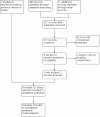
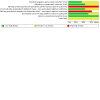
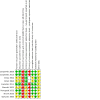
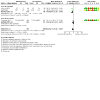
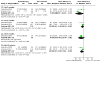
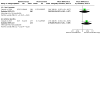
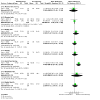
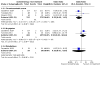
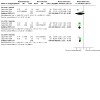
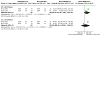
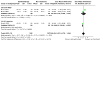
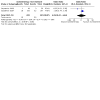
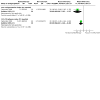
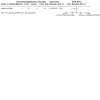
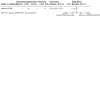
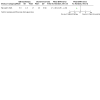

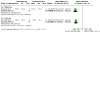
Update of
-
Balneotherapy for chronic venous insufficiency.Cochrane Database Syst Rev. 2019 Aug 26;8(8):CD013085. doi: 10.1002/14651858.CD013085.pub2. Cochrane Database Syst Rev. 2019. Update in: Cochrane Database Syst Rev. 2023 Jan 9;1:CD013085. doi: 10.1002/14651858.CD013085.pub3. PMID: 31449319 Free PMC article. Updated.
References
References to studies included in this review
Carpentier 2009 {published data only}
Carpentier 2014 {published data only}
-
- NCT00838500. Thermes et veines: spa for prevention of leg ulcers. clinicaltrials.gov/ct2/show/NCT00838500 (first received 6 February 2009).
Ernst 1991 {published data only}
-
- Ernst E, Saradeth T, Resch KL. A single blind randomized, controlled trial of hydrotherapy for varicose veins. Vasa 1991;20(2):147-52. [MEDLINE: ] - PubMed
Ernst 1992 {published data only}
Forestier 2014 {published data only}
-
- NCT01956318. Crenobalneotherapy in the treatment of chronic venous insufficiency. clinicaltrials.gov/ct2/show/NCT01956318 (first received 8 October 2013).
Mancini 2003 {published data only}
Menegatti 2021 {published data only}
-
- Menegatti E, Masiero S, Zamboni P, Avruscio G, Tessari M, Pagani A, et al. Randomized controlled trial on dryland and thermal aquatic standardized exercise protocol for chronic venous disease (DATA study). Journal of Vascular Surgery: Venous and Lymphatic Disorders 2021;9(5):1226-34.e2. [DOI: 10.1016/j.jvsv.2020.12.078] - DOI - PubMed
Sharifi 2021 {published data only}
-
- NCT02553720. Aqua therapy in deep venous thrombosis and insufficiency (ATLANTIS). clinicaltrials.gov/ct2/show/NCT02553720 (first received 18 September 2015).
Stefanini 1996 {published data only}
-
- Stefanini L, Gigli P, Galassi A, Pierallini F, Tillieci A, Scalabrino A. Pharmacologic treatment and/or balneotherapy of chronic venous insufficiency [Trattamento farmacologico e/o balneoterapico dell'insufficienza venosa cronica]. Gazzetta Medica Italiana 1996;155(4):179-85.
References to studies excluded from this review
Aquino 2016 {published data only}
-
- Aquino MA, Paixão LC, Leal FJ, Couto RC. Analysis of the effects of aquatic exercise on the quality of life of people with chronic venous disease [Análise dos efeitos dos exercícios aquáticos na qualidade de vida de indivíduos com doença venosa crônica]. Jornal Vascular Brasileiro 2016;15(1):27-33. [EMBASE: 10.1590/1677-5449.005115]
Blain 2016 {published data only}
Brock 2001 {published data only}
-
- Brock FE. Synergystic effect of vein-typical hydrotherapy according to Kneipp and topical arnica-treatment in patients with chronic venous insufficiency [Additiver Effekt venentypischer Hydrotherapie nach Kneipp und lokaler Arnika-Anwendung bei Patienten mit chronisch venöser Insuffizienz – Synergismus naturheilkundlicher Therapien]. Erfahrungsheilkunde 2001;50(6):357-63. [DOI: 10.1055/s-2001-15774] - DOI
Carpentier 2002 {published data only}
-
- Carpentier PH, Fechoz C, Poensin D, Satger B. Influence of spray application of La Lechere mineral water on the cutaneous microcirculation in the lower limbs in healthy subjects [Influence de l'application locale d'eau thermale de la léchère en spray sur la microcirculation cutanée des membres inférieurs]. Journal des Maladies Vasculaires 2002;27(4):211-3. - PubMed
Coccheri 2002 {published data only}
-
- Coccheri S, Nappi G, Valenti M, Di Orio F, Altobelli E, De Luca S, et al. Changes in the use of health resources by patients with chronic phlebopathies after thermal hydrotherapy. Report from the Naiade project, a nation-wide survey on thermal therapies in Italy. International Angiology 2002;21(2):196-200. - PubMed
Costantino 2003 {published data only}
-
- Costantino M, Nappi G, Granieri MA, Lampa E. Effects of thermal therapy in venous chronic insufficiency: experimental-clinic study. Medicina Clinica e Termale 2003;15(53-54):469-76.
Hartmann 1991 {published data only}
-
- Hartmann B, Drews B, Bassenge E. Effects of hetero-thermal water administration on leg vein hemodynamics, skin microcirculation and O 2 tension in chronic venous insufficiency. Vasa. Supplementum 1991;33:226. - PubMed
Hartmann 1993 {published data only}
-
- Hartmann B, Drews B, Bassenge E. Effects of bathing in CO 2-containing thermal water in the venous hemodynamics of healthy persons and patients with venous diseases. VASA. Supplementum 1993;3(6):153-7.
Hartmann 1995 {published data only}
-
- Hartmann B, Drews B, Kayser T, Bassenge E. Venous function in patients with venous disease and healthy controls before and after a bathing procedure and subsequent cold stimulus. Journal of Japanese Association of Physical Medicine Balneology and Climatology 1995;58(2):134-40.
-
- Hartmann BR, Drews B, Bassenge E. Venous function in patients with venous disease and healthy controls before and after a bathing procedure and subsequent cold stimulus. International Journal of Angiology 1998;7(3):252-4. [PMID: ] - PubMed
NCT00348907 {published data only}
-
- NCT00348907. EVENT: hydrotherapy and deep venous thrombosis. clinicaltrials.gov/ct2/show/NCT00348907 (first received 6 July 2006).
Roques 2012 {published data only}
-
- Roques C, Mancret RC, Tabone W. Beneficial effect of balneotherapy: achievements of the French association of balneotherapy research and methodological difficulties. Annals of Physical and Rehabilitation Medicine 2012;55 (Suppl 1):e349-51. [DOI: 10.1016/j.rehab.2012.07.891] - DOI
Schumann 2011 {published data only}
-
- Schumann H, Calow T, Weckesser S, Muller ML, Hoffmann G. Water-filtered infrared A for the treatment of chronic venous stasis ulcers of the lower legs at home: a randomized controlled blinded study. British Journal of Dermatology 2011;165(3):541-51. [DOI: 10.1111/j.1365-2133.2011.10410.x] - DOI - PubMed
References to studies awaiting assessment
Charsouei 2021 {published data only}
-
- Charsouei S, Sheghaghi N, Alvandfar D. A course of hydrotherapy exercises on varicose veins pain in postmenopausal women with multiple sclerosis. The Iranian Journal of Obstetrics, Gynecology and Infertility 2021;24(10):25-32. [DOI: 10.22038/ijogi.2021.19386] - DOI
Additional references
Angoules 2014
-
- Angoules AG. Conservative treatment of chronic venous insufficiency. Journal of Novel Physiotherapies 2014;5(1):1-2. [DOI: 10.4172/2165-7025.1000e135] - DOI
Becker 2009
Beebe‐Dimmer 2005
Bender 2005
Bergan 2006
Brooks 1996
-
- Brooks R. EuroQol: the current state of play. Health Policy 1996;37(1):53-72. [MEDLINE: ] - PubMed
Caggiati 2018a
Caggiati 2018b
Carroll 2013
-
- Carroll C, Hummel S, Leaviss J, Ren S, Stevens JW, Everson-Hock E, et al. Clinical effectiveness and cost-effectiveness of minimally invasive techniques to manage varicose veins: a systematic review and economic evaluation. Health Technology Assessment 2013;17(48):1-141. [DOI: 10.3310/hta17480] - DOI - PMC - PubMed
Castro‐Ferreira 2018
Chen 2002
-
- Chen MJ, Fan X, Moe ST. Criterion-related validity of the Borg ratings of perceived exertion scale in healthy individuals: a meta-analysis. Journal of Sports Sciences 2002;20:873-99. - PubMed
Covidence [Computer program]
-
- Covidence. Version accessed 23 November 2022. Melbourne: Veritas Health Innovation. Available at covidence.org.
Da Silva 2010
-
- Da Silva GC, Medeiros RJ, Oliveira LS, Araújo Júnior AT, Aniceto RR, Sousa MS, et al. Strength training does not affect the diameter of the main veins of lower limbs in adult women with mild to moderate chronic venous insufficiency [Treinamento de sobrecarga muscular não afeta o diâmetro das principais veias dos membros inferiores em mulheres adultas com insuficiência venosa]. Revista Brasileira de Medicina do Esporte 2010;16(6):413-7.
Eklöf 2004
Gloviczki 2011
-
- Gloviczki P, Comerota AJ, Dalsing MC, Eklof BG, Gillespie DL, Gloviczki ML, et al. The care of patients with varicose veins and associated chronic venous diseases: clinical practice guidelines of the Society for Vascular Surgery and the American Venous Forum. Journal of Vascular Surgery 2011;53(5):2S-48S. [DOI: 10.1016/j.jvs.2011.01.079] - DOI - PubMed
GRADE 2004
GRADEpro GDT [Computer program]
-
- GRADEpro GDT. Version accessed 23 July 2018. Hamilton (ON): McMaster University (developed by Evidence Prime), 2015. Available at gradepro.org.
Gutenbrunner 2010
Higgins 2011
-
- Higgins JP, Green S, editor(s). Cochrane Handbook for Systematic Reviews of Interventions Version 5.1 (updated March 2011). The Cochrane Collaboration, 2011. Available from training.cochrane.org/handbook/archive/v5.1/.
Higgins 2022
-
- Higgins JP, Thomas J, Chandler J, Cumpston M, Li T, Page MJ, Welch VA, editor(s). Cochrane Handbook for Systematic Reviews of Interventions Version 6.3 (updated February 2022). Cochrane, 2022. Available from training.cochrane.org/handbook.
Johnson 1990
Klick 2008
-
- Klick J, Stratmann T. Do spa visits improve health: evidence from German micro data. Eastern Economic Journal 2008;34(3):364-74. [DOI: 10.1057/palgrave.eej.9050038] - DOI
Konschake 2016
Launois 1996
-
- Launois R, Reboul-Marty J, Henry B. Construction and validation of a quality of life questionnaire in chronic lower limb venous insufficiency (CIVIQ). Quality of Life Research 1996;5(6):539-54. [MEDLINE: ] - PubMed
Lee 2016
-
- Lee BB, Nicolaides AN, Myers K, Meissner M, Kalodiki E, Allegra C, et al. Venous hemodynamic changes in lower limb venous disease: the UIP consensus according to scientific evidence. International Angiology 2016;35(3):236-352. - PubMed
Lefebvre 2022
-
- Lefebvre C, Glanville J, Briscoe S, Featherstone R, Littlewood A, Marshall C, et al. Chapter 4: Searching for and selecting studies. In: Higgins JP, Thomas J, Chandler J, Cumpston M, Li T, Page MJ, Welch VA, editor(s). Cochrane Handbook for Systematic Reviews of Interventions Version 6.3 (updated February 2022). Cochrane, 2022. Available from training.cochrane.org/handbook.
Martinez‐Zapata 2016
Motykie 1999
-
- Motykie GD, Caprini JA, Arcelus JI, Reyna JJ, Overom E, Mokhtee D. Evaluation of therapeutic compression stockings in the treatment of chronic venous insufficiency. Dermatologic Surgery 1999;25:116-20. [PMID: ] - PubMed
Nicolaides 2014
-
- Nicolaides A, Kakkos S, Eklof B, Perrin M, Nelzen O, Neglen P, et al. Management of chronic venous disorders of the lower limbs – guidelines according to scientific evidence. International Angiology 2014;33(2):87-208. - PubMed
Padberg 2004
Pasek 2010
-
- Pasek J, Ciesla G. Health resort treatment – a new chance for the treatment of vessel diseases? Acta Angiologica 2010;16:1-16.
Paty 2015
Perrin 2016
-
- Perrin M, Eklöf B, Rij A, Labropoulos N, Vasquez M, Nicolaides A, et al. Venous symptoms: the SYM Vein Consensus statement developed under the auspices of the European Venous Forum. International Angiology 2016;35(4):374-98. [PMID: ] - PubMed
Pittler 2012
Plot Digitizer
-
- Plot Digitizer. Available from plotdigitizer.sourceforge.net/ (accessed 12 February 2019).
Raju 2007
Review Manager 2020 [Computer program]
-
- Review Manager 5 (RevMan 5). Version 5.4. Copenhagen: The Cochrane Collaboration, 2020.
RevMan Web 2022 [Computer program]
-
- Review Manager Web (RevMan Web). Version 4.12.0. The Cochrane Collaboration, 2022. Available at revman.cochrane.org.
Rossi 2015
-
- Rossi FH, Volpato MG, Metzger PB, Beteli CB, Almeida BL, Rossi CB, et al. Relationships between severity of signs and symptoms and quality of life in patients with chronic venous disease. Jornal Vascular Brasileiro 2015;14(1):22-8. [DOI: 10.1590/1677-5449.20140039] - DOI
Rutherford 2000
-
- Rutherford RB, Padberg FT, Comerota AJ, Kistner RL, Meissner MH, Moneta GL. Venous severity scoring: an adjunct to venous outcome assessment. Journal of Vascular Surgery 2000;31(6):1307-12. [PMID: ] - PubMed
Verhagen 2007
Verhagen 2015
Villalta 1994
-
- Villalta S, Bagatella P, Piccioli A, Lensing A, Prins M, Prandoni P. Assessment of validity and reproducibility of a clinical scale for the post-thrombotic syndrome. Haemostatis 1994;24:158a.
Ware 1998
Wong 2012
Wood‐Dauphinee 1999
-
- Wood-Dauphinee S. Assessing quality of life in clinical research: from where have we come and where are we going? Journal of Clinical Epidemiology 1999;52(4):355-63. - PubMed
References to other published versions of this review
de Moraes Silva 2018
Publication types
MeSH terms
Grants and funding
LinkOut - more resources
Full Text Sources
Medical

